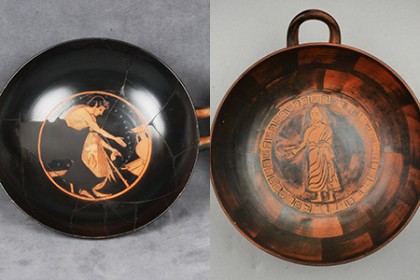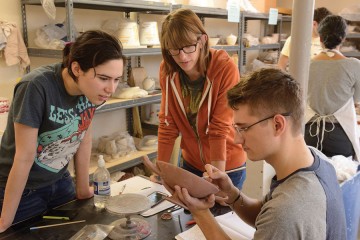For the past 13 weeks, the students in Sanchita Balachandran's "Recreating Ancient Greek Ceramics" class have undertaken a distinctly different type of apprenticeship.

Image caption: Left: The ancient version (JHUAM B4) is a cup by the Phintias Painter, dated to 510 BCE, from ancient Greece Right: The new version (“2015cup”) was potted by ceramic artists from Baltimore Clayworks Matthew Hyleck and Cami Ascher, and painted by JHU undergraduates Hana Chop, Savannah De Montesquiou, and Arthur Zhang
Throughout this hands-on course in experiential archaeology, they have consulted the work of experts and practiced throwing clay pots. They've designed images and experimented with slip and various tools used to paint the substance onto clay. And they've built a kiln, fired their pottery, and examined it under a portable x-ray fluorescence instrument—all to understand the world of the ancient Greek potters and their apprentices who made kylikes, the red-figure pottery drinking bowls created between the 6th and 4th centuries BCE.
"The idea is to be thoughtful at every stage," says Balachandran, who is the curator/conservator of the Johns Hopkins Archaeological Museum. "To look at clay, make shapes, to choose images and paint, to go through the fire and kiln process, and to consider the final product. This leads to a deeper understanding of both the art and the object, because when you go through the process, you get a visceral sense of how things got there."
Throughout the semester, the students have kept a detailed blog of their weekly process.
Through funding from the Program in Museums and Society at Johns Hopkins and the Andrew W. Mellon Foundation, the entire project has also been documented in a short film, directed by Bernadette Wegenstein, director of the Center for Advanced Media Studies. The film will debut early this summer.
The students have also written a short segment for "Humanities Connection", a radio program produced by the Maryland Humanities Council. The segment, which will will air on WYPR 88.1 FM at 4:44 p.m. today, features sophomores Anna Soifer and Savannah de Montesquiou along with the course's graduate assistant, Ross Brendle of the Department of Classics.
Posted in Arts+Culture, Student Life, Politics+Society
Tagged program in museums and society, archaeological museum, pottery









